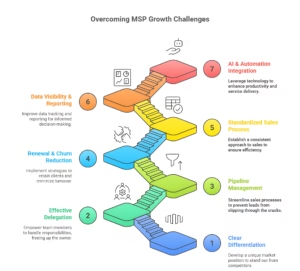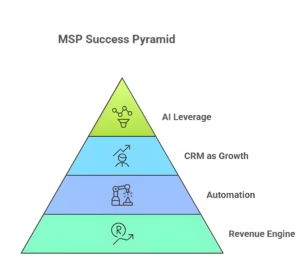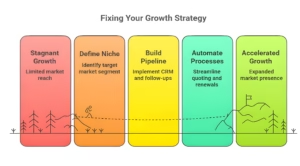Most MSPs don’t fail because of competition; they fail because they rely on outdated growth habits. This post breaks down the biggest strategy blind spots holding MSPs back.
This shows how modern CRMs, automation, and AI can turn stalled growth into a predictable revenue engine.
Growth should feel strategic, not stressful.
But for many MSPs, it’s the opposite. You’re working harder every quarter to get more clients, more proposals, more platforms, yet revenue growth stays flat.
The culprit isn’t your service quality or your market; it’s the system behind your sales and operations.
According to Empellor CRM’s MSP Revenue Flywheel research, over 60% of MSPs report stalled growth due to weak sales systems and reactive account management. Many firms still rely on referrals, manual quoting, and disconnected tools that lack scalability.
The good news? Once you establish your growth infrastructure, strategy, CRM, and automation foundation, momentum compounds rapidly. You stop chasing deals and start building a growth flywheel that runs itself.
Let’s unpack where most MSP growth strategies go wrong (and how to build one that finally works.
The Hidden Cost of “Business as Usual”
For most MSPs, “business as usual” means a steady stream of referrals, solid client retention, and the occasional upsell. It feels safe, but it’s quietly killing your growth potential.
Relying on referrals and break/fix thinking locks you into reactive mode. You’re waiting for opportunities instead of engineering them. When your next sale depends on a happy client remembering to make an introduction, your pipeline becomes unpredictable,and so does your revenue.
The other silent killer? Commoditization.
Every MSP promises “great service” and “responsive support.” But in 2025, that’s table stakes, not differentiation. Buyers expect proactive strategy, automation insights, and integrated technology recommendations. If all you offer is uptime, your clients will shop on price.
Empellor CRM’s MSP research found that nearly 70% of MSPs see margin compression from commoditization, even though their service quality remains high. It’s not about doing more tickets; it’s about selling value instead of hours.
Snippet-ready stat: Most MSPs lose growth not from competition, but from failing to modernize their sales and revenue systems.
“Business as usual” feels comfortable, but it hides mounting opportunity costs, missed leads, weaker margins, and a team that’s constantly busy but never scaling.
The fix starts with recognizing where the real leaks are.

7 Fatal Growth Gaps That Sink Most MSPs
Even the best MSP leaders fall into predictable traps that quietly drain momentum. Let’s break down the seven most common, and how to plug each one before it caps your growth.
1. No Clear Differentiation Strategy
If your website says “We manage IT,” you sound like everyone else.
That sameness fuels price wars, where the lowest bid wins, not the best value.
Empellor CRM’s MSP research shows that 72% of prospects can’t tell one MSP’s pitch from another. In a market this crowded, clarity beats capability.
To win in 2025, your growth strategy must define who you serve, why you’re different, and what measurable outcomes you deliver, whether that’s compliance-grade security for healthcare or productivity optimization for remote teams.
Tip: Build a positioning statement that finishes this sentence: “We help [ideal client] achieve [specific result] by [unique approach].”
2. Owner Bottleneck & Weak Delegation
Many MSPs hit the “technician trap” described in The E-Myth, where the founder still runs sales calls, builds quotes, and handles renewals.
It’s not sustainable.
When everything routes through the owner, growth stalls. Deals slow down, and team members never learn how to close on their own.
Modern MSPs scale faster by documenting their sales playbooks and delegating quoting and renewal tasks via CRM workflows.
Empellor’s clients who built structured sales processes saw 30–40% faster deal cycles once quoting and follow-ups no longer depended on a single person.
3. Pipeline Leaks & Missed Follow-Ups
If your CRM is a spreadsheet or buried inside a PSA like ConnectWise or Autotask, you’re flying blind.
Leads go cold because there’s no structured follow-up cadence or visibility.
A true growth CRM doesn’t just store contacts; it automates reminders, sequences outreach, and tracks opportunity stages.
Without that, MSPs lose 20–30% of their potential pipeline simply due to “out of sight, out of mind.”
4. Missed Renewals & Churn
Manual reminders are silent killers. One missed renewal email can erase a year of recurring revenue.
MSPs that automate renewal tracking through Work 365 or Dynamics 365 see dramatic retention gains because every contract has a lifecycle view, alerts, and auto-renew workflows.
Remember: churn hurts twice – you lose a client and spend more to replace them.
Empellor’s data shows that a 5% reduction in churn can increase MSP profits by 25%.
5. No Standardized Sales Process (Quoting Chaos)
If quoting involves Word docs, Excel sheets, and approvals bouncing back and forth via email, you’re leaking margin.
Errors, delays, and version mismatches erode confidence — internally and with clients.
Using Experlogix CPQ integrated with Dynamics 365 eliminates those leaks by ensuring accuracy, speed, and profitability on every deal.
Pro insight: Automated CPQ can save up to 40 minutes per quote and increase close rates by 28%.
6. Poor Data Visibility & Reporting
If you can’t see MRR, churn, and pipeline on a single dashboard, you can’t lead proactively.
Disconnected tools make every forecast guesswork.
Integrating your PSA, CRM, and financial data into Power BI gives instant visibility into performance.
Modern MSPs use these dashboards to predict growth, not just report it.
7. Neglecting AI & Automation
Still managing leads in email and Excel? You’re falling behind.
AI tools like Microsoft Copilot now help MSPs forecast revenue, identify churn risk, and accelerate deal creation.
Those who adopt early don’t just save time; they turn data into decisions.
Empellor’s research found MSPs using AI-assisted sales forecasting grew 1.6x faster than those that didn’t.
These gaps aren’t isolated; they compound. But fixing them unlocks the system that drives every fast-scaling MSP: a connected, data-driven revenue engine.
What Successful MSPs Do Differently
High-growth MSPs aren’t smarter or luckier; they’ve built better systems.
They stopped relying on “heroic effort” and started running their businesses like a repeatable machine.
Here’s what sets them apart:
Build a Revenue Engine (Not Just a Sales Funnel)
Instead of chasing one-off deals, successful MSPs align sales, service, billing, and finance around a shared set of KPIs.
Every department feeds data back into the same system pipeline: health, ticket trends, renewal status, and MRR movement.
That connected visibility turns growth from guesswork into a process.
According to Empellor CRM’s Revenue Flywheel research, MSPs with integrated CRM + PSA workflows grow 2.3x faster than those using disconnected tools.
Automate Renewals and Quoting to Protect Margin
Margins erode with manual steps, quotes waiting on approvals, and renewals lost in inboxes.
Top-performing MSPs use tools like Experlogix CPQ for quoting and Work 365 for renewals, eliminating delays and errors.
The result:
- Renewals never slip.
- Quotes go out in minutes, not days.
- Sales teams focus on relationships, not paperwork.
Treat CRM as a Growth System, Not a Database
Average MSPs use CRM to “store contacts.”
Leaders use it to forecast revenue, trigger automation, and track every KPI.
They build playbooks, automate nurture flows, and track conversion by stage.
The CRM becomes their operating system for predictable growth, not just a record-keeping tool.
Leverage AI (Copilot) for Productivity and Insight
AI is no longer futuristic; it’s a force multiplier.
Using Microsoft Copilot, MSPs can analyze deal data, summarize client sentiment from tickets, and even draft proposals automatically.
These firms make better decisions faster, not because they work harder, but because their systems think with them.
When sales, service, finance, and forecasting run on a single, connected platform, MSPs stop guessing and start growing.
The shift isn’t about tools; it’s about building an engine that compounds momentum every month.
How to Fix Your Growth Strategy (Step-by-Step Playbook)
Fixing your MSP’s growth strategy isn’t about reinventing the wheel; it’s about installing the right systems, in the correct order so that they can spin on their own. Here’s how to turn chaos into a predictable revenue engine.
Step 1: Define Your Niche & Value Proposition
Stop competing on price.
Decide who you serve best and why they should pay more for you.
Look at your client base, which verticals deliver the most profitable, least reactive work? Healthcare, finance, construction, education? Build your story around them.
Empellor CRM’s MSP research found that firms with vertical specialization grow 2x faster than generalists.
Pro move: Rebuild your messaging around business outcomes, not IT tasks. “We reduce downtime” becomes “We increase your team’s billable hours by 15%.”
Step 2: Build Pipeline Discipline (CRM + Structured Follow-Ups)
Leads die in silence.
Without automation and accountability, your sales pipeline becomes a graveyard of “maybe next quarter.”
Integrate your PSA with Dynamics 365 CRM, and use automated follow-up sequences, reminders, and deal stages.
This ensures no leads get lost and everyone knows what’s next.
Firms that implemented structured CRM cadences reported a 37% increase in conversion rates, according to Empellor’s MSP dataset.
Step 3: Automate Quoting & Renewals (Experlogix CPQ + Work 365)
Manual quoting and renewals eat time and margin.
Every missed renewal or mispriced quote directly impacts recurring revenue.
By combining Experlogix CPQ for quoting and Work 365 for renewals, MSPs can automate approvals, enforce pricing accuracy, and eliminate forgotten contracts.
Quick stat: MSPs using automated CPQ workflows saw a 22% margin improvement year-over-year.
Step 4: Instrument Your KPIs (Power BI Dashboards for MRR, Churn, CAC/LTV)
If you can’t measure it, you can’t scale it.
Pull your CRM, PSA, and accounting data into Power BI dashboards to monitor:
- Monthly Recurring Revenue (MRR)
- Churn Rate
- Customer Acquisition Cost (CAC)
- Lifetime Value (LTV)
- Sales Cycle Length
Top MSPs run these dashboards weekly, not quarterly. It lets them pivot faster, spot trends early, and fix leaks before they drain growth.
Step 5: Train Your Team for Adoption (Change Management & Playbooks)
The best system is useless if no one uses it.
MSPs that skip training end up back in spreadsheets six months later.
Use simple, role-specific playbooks and “mini wins” to build buy-in.
Sales teams should see faster closes; service should see cleaner handoffs. That’s how change sticks.
Empellor CRM recommends a “3-3-3 rollout”: three process wins, three metrics tracked, and three champions accountable for adoption.
Each step compounds the next, specialization drives clearer messaging, which drives better pipeline discipline, which drives more predictable revenue.
That’s how you turn your MSP from a reactive service provider to a proactive growth engine.
Final Thoughts: Turning Failure into a Growth Flywheel
Most MSP growth strategies don’t fail because leaders lack skill or drive; they fail because the systems beneath them were never designed to scale.
When your CRM is just a contact list, your quoting lives in Excel, and your renewals sit in inboxes, every month starts from zero. However, once you integrate your sales, service, billing, and data systems into a single platform, growth becomes predictable, repeatable, and compounding.
Empellor CRM’s MSP Revenue Flywheel research found that firms with integrated CRM + automation stack (Dynamics 365, Experlogix CPQ, Work 365, and Power BI) outperformed peers by 47% in revenue growth over 18 months. The difference wasn’t marketing spend, it was system design.
Your next stage of growth doesn’t come from “working harder.” It comes from upgrading how your MSP runs revenue.
Stop patching leaks, start building the flywheel.
A modern CRM strategy doesn’t just organize your business; it transforms chaos into clarity.
Because CRMShouldntSuck, it should scale with you.
FAQs: Common MSP Growth Questions Answered
Q1: Do I really need a CRM if I already use ConnectWise or Autotask?
- Yes, and here’s why.
PSAs like ConnectWise and Autotask are great for service delivery and ticketing, but they’re not built for modern sales growth.
A true CRM (like Dynamics 365) manages pipeline visibility, forecasting, lead scoring, and automation, things your PSA can’t do effectively.
Empellor’s MSP data shows that firms using both CRM and PSA experience 41% faster deal cycles than those relying solely on PSA.
Think of it this way: your PSA runs your operations; your CRM runs your growth.
Q2: What’s the fastest way to plug revenue leaks in my MSP?
- Start with renewals and follow-ups.
Missed renewals and cold leads are the two biggest silent killers of recurring revenue.
Automate both using Work 365 for renewals and Dynamics 365 CRM for structured follow-ups.
You’ll recover lost contracts and prevent future churn without adding more staff.
A simple automated renewal workflow can protect up to 15% of annual revenue that would otherwise disappear unnoticed.
Q3: How can AI actually help MSP growth without adding overhead?
- AI isn’t about replacing people — it’s about amplifying their focus.
With Microsoft Copilot, MSPs can:
- Summarize sales pipelines and instantly forecast revenue.
- Analyze churn risk based on client sentiment or ticket history.
- Generate draft proposals, emails, and renewal summaries automatically.
Instead of adding complexity, AI removes manual work, giving your team time back to focus on selling, supporting, and strategizing.
Q4: What KPIs predict MSP growth?
- Track these five metrics consistently:
- MRR Growth Rate – Core indicator of recurring revenue health.
- Churn Rate – Anything above 5% annually signals a problem.
- Lead-to-Close Rate – Measures sales efficiency.
- Average Contract Value (ACV) – Indicates whether you’re upselling effectively.
- Customer Acquisition Cost (CAC) vs Lifetime Value (LTV) – Defines profitability and scalability.
MSPs that monitor these KPIs in Power BI dashboards can spot bottlenecks early and make data-driven decisions, not guesses.
Modern growth is about clarity, not chaos.
Once your data, CRM, and processes talk to each other, growth stops being unpredictable and starts being intentional.
Book your MSP Growth Assessment today and see how Empellor CRM helps turn your sales, service, and finance processes into a unified growth engine.





